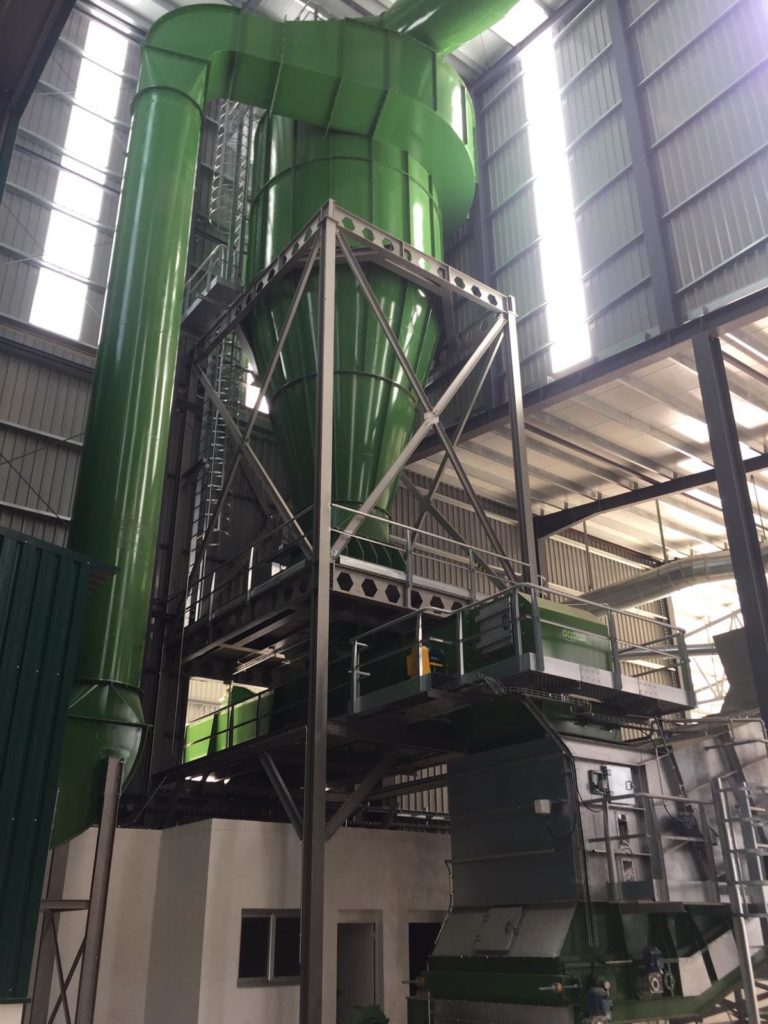Activity at FORSA
FORSA’s activity is the production of raw materials for the food industry in general. We cultivate, advise and manage different farms in the Monegros area in order to produce fodder.
For a correct handling of the product and so that it arrives in the best conditions to our customers, we have the technology of dehydrated fodder and high knowledge of the crop.
Alfalfa
Alfalfa (Medicago sativa L.) is a multi-annual leguminous plant that plays an important role in the production of vegetable protein for use in the feed rations of ruminant animals.
In addition, alfalfa, as a legume, fixes atmospheric nitrogen thanks to the symbiotic relationship that exists between its root system and the rhizobium meliloti bacterium. Therefore, the plant also has great agronomic advantages, since it is a soil-improving crop, both for its nitrogen supply and for its contribution to the improvement of soil structure. Thus, the alfalfa crop is an indispensable part of the crop leaves of any rotation.
Dehydrated alfalfa, compared to alfalfa sticks, has the advantage of homogeneity and uniform quality throughout the year. The presentation marketed by FORSA is in the form of bales.
Control and follow-up
In order to obtain the best quality alfalfa, it is essential to carry out a follow-up from the field to its reception at the factory. For this reason, it is important that specialized technicians control and monitor the crop to determine the optimum times for mowing and harvesting, as well as to monitor possible pests that may occur in the plots.
The work begins with the identification of the contracted farms, followed by the preparation of the cutter wheel. Thus, the cutting order to be followed in the plots is determined and the consequent planning of the field work and the reception of the chopped alfalfa in the factory, so that it can be processed daily and a quality product is obtained.
Sowing
The most common pre-planting operations prior to sowing alfalfa are usually vertical operations such as subsoiling or chiseling, although in plots with preceding crops such as corn, harrows, moldboard plows or tillers are used to wrap the plant cover. It is important to point out that the planting bed should be as well conditioned as possible, since, in addition to facilitating the nascence, it will facilitate the subsequent work of mowing and harvesting, hence the roller becomes a very suitable work for the development of the activity.
The most common sowing dates are in spring and autumn, and parallel herbicide applications to control weeds are becoming more and more frequent, thus enhancing the quality of the alfalfa. For sowing, it is advisable to use certified seed, free of cuscuta seeds and other weeds.
The most commonly used variety is Aragón and the sowing rate is usually 35 to 40 kg/ha.
Mowing
Alfalfa mowing begins in April, and mowing frequency is usually based on flowering. Thus, the spacing between cuts varies between 26 and 32 days, expanding in the first and last cuts, and sticking closer to 28 – 30 days in the hottest months. Thus, in irrigated areas, the alfalfa campaign generates between 5 – 6 cuts per year.
The height of cut is about 4 centimeters, although it depends on the machine that performs it, as disc mowers usually leave less stubble than saw mowers. In large plots with sprinkler irrigation, self-propelled saw mowers with conditioners tend to be used, thus accelerating the drying process.
Raking
The functions of raking are to reduce the drying period of alfalfa in the field and to prepare the final strands for later collection with chopper wagons.
Raking is not done at fixed dates or times, as it must be done with sufficient moisture so that the mown alfalfa does not leaf out, and at the same time without too much wetting, otherwise the drying process would not be facilitated.
The machinery used for this work must be adjusted according to the characteristics of the terrain, avoiding that the tines drag stones, because apart from reducing the quality of the alfalfa, this could cause serious damage to the harvesting machinery. The most suitable rakes for a good job are those of the “book” type, or those with rotors, discarding those of the sunflower type, as the latter move many stones.
Collection
The harvesting of alfalfa is the most delicate factor of the whole cycle, since a good final product will depend on it. Thus, before loading begins, there must be adequate monitoring in the field to determine the optimum time for harvesting.
In summer, the collection schedule is usually at night, and in the cooler months or when the humidity at night is higher, it is usually collected late in the morning or in the afternoon. For this purpose, it will be necessary to work at optimum alfalfa moisture levels ranging between 30 – 40 percent, which will also depend on the type of machinery used.
The drying period in the field after mowing is usually around 3 days, although this will be influenced by the weather, the collection system, raking, mowing machines, or the number of days without irrigation prior to mowing.
Factory
The reception of the product in the factory is controlled, thus completing the pre-established cycle in the field. In this way, peak production periods are regulated, avoiding the entry of more alfalfa than can be processed each day, thus avoiding fermentation processes that would diminish the final quality of the product.
At the reception beach, the product is distributed according to the incoming humidity and quality of the product, thus facilitating its processing and subsequent classification into homogeneous batches.
In recent years, market demands have made alfalfa manufacturers more meticulous on this point, giving priority to harvesting by teams rather than on an individual basis.
Sample and analysis
When the alfalfa arrives at the factory, the trailers are weighed on the scale and once unloaded, several representative samples are taken for subsequent analysis.
The controls are based on a visual analysis, which determines their classification and distribution on the dehydration plant beach. Subsequently, other aspects based on the determination of the moisture content of the alfalfa and the measurement of its protein are analyzed in the factory laboratory.
Drying ovens and infrared NIR meters are used for these analyses.
Efficient quality control will serve to classify the product before processing, thus facilitating the subsequent organization of bale lots.

Packaging and labeling
The alfalfa dehydration process ends with baling, but before storage, a final check must be made, which consists of measuring the moisture content of the bale. If the bale measurement is adequate, the bale is marked with a label identifying the marketing company: FORSA.
The last phase concludes with the storage of the bales, classifying them by batches of similar characteristics for subsequent sale.
The final product, as it could not be otherwise, is a dehydrated alfalfa bale of 450 kg or 750 kg, with dimensions of 110x110x85 cm or 220x110x85 cm. and an optimal quality for the cattle to make the best conversion according to their needs.
